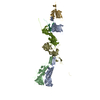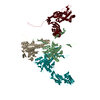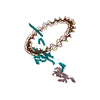+ Open data
Open data
- Basic information
Basic information
| Entry | Database: PDB / ID: 8q7d | ||||||
|---|---|---|---|---|---|---|---|
| Title | Neck of phage 812 after tail contraction (C12) | ||||||
 Components Components |
| ||||||
 Keywords Keywords | VIRUS / phage / neck / portal / connector | ||||||
| Function / homology | Bacteriophage/Gene transfer agent portal protein / Phage portal protein / viral capsid / DNA / DNA (> 10) / DNA (> 100) / Portal protein / Neck protein Function and homology information Function and homology information | ||||||
| Biological species |  Staphylococcus phage 812 (virus) Staphylococcus phage 812 (virus) | ||||||
| Method | ELECTRON MICROSCOPY / single particle reconstruction / cryo EM / Resolution: 3.07 Å | ||||||
 Authors Authors | Cienikova, Z. / Siborova, M. / Fuzik, T. / Plevka, P. | ||||||
| Funding support |  Czech Republic, 1items Czech Republic, 1items
| ||||||
 Citation Citation |  Journal: To Be Published Journal: To Be PublishedTitle: Genome anchoring, retention, and release by neck proteins of Herelleviridae phage 812 Authors: Cienikova, Z. / Novacek, J. / Siborova, M. / Popelarova, B. / Fuzik, T. / Benesik, M. / Bardy, P. / Plevka, P. | ||||||
| History |
|
- Structure visualization
Structure visualization
| Structure viewer | Molecule:  Molmil Molmil Jmol/JSmol Jmol/JSmol |
|---|
- Downloads & links
Downloads & links
- Download
Download
| PDBx/mmCIF format |  8q7d.cif.gz 8q7d.cif.gz | 249.1 KB | Display |  PDBx/mmCIF format PDBx/mmCIF format |
|---|---|---|---|---|
| PDB format |  pdb8q7d.ent.gz pdb8q7d.ent.gz | 185.3 KB | Display |  PDB format PDB format |
| PDBx/mmJSON format |  8q7d.json.gz 8q7d.json.gz | Tree view |  PDBx/mmJSON format PDBx/mmJSON format | |
| Others |  Other downloads Other downloads |
-Validation report
| Summary document |  8q7d_validation.pdf.gz 8q7d_validation.pdf.gz | 1.2 MB | Display |  wwPDB validaton report wwPDB validaton report |
|---|---|---|---|---|
| Full document |  8q7d_full_validation.pdf.gz 8q7d_full_validation.pdf.gz | 1.2 MB | Display | |
| Data in XML |  8q7d_validation.xml.gz 8q7d_validation.xml.gz | 40.3 KB | Display | |
| Data in CIF |  8q7d_validation.cif.gz 8q7d_validation.cif.gz | 61.8 KB | Display | |
| Arichive directory |  https://data.pdbj.org/pub/pdb/validation_reports/q7/8q7d https://data.pdbj.org/pub/pdb/validation_reports/q7/8q7d ftp://data.pdbj.org/pub/pdb/validation_reports/q7/8q7d ftp://data.pdbj.org/pub/pdb/validation_reports/q7/8q7d | HTTPS FTP |
-Related structure data
| Related structure data |  18213MC  8q01C  8q1iC  8qekC  8qemC  8qgrC  8qjeC  8qkhC  8r5gC  8r69C M: map data used to model this data C: citing same article ( |
|---|---|
| Similar structure data | Similarity search - Function & homology  F&H Search F&H Search |
- Links
Links
- Assembly
Assembly
| Deposited unit | 
|
|---|---|
| 1 | x 12
|
- Components
Components
| #1: Protein | Mass: 34191.703 Da / Num. of mol.: 1 / Source method: isolated from a natural source / Details: Adaptor protein / Source: (natural)  Staphylococcus phage 812 (virus) / Strain: K1-420 / References: UniProt: A1YTN6 Staphylococcus phage 812 (virus) / Strain: K1-420 / References: UniProt: A1YTN6 |
|---|---|
| #2: Protein | Mass: 64155.684 Da / Num. of mol.: 1 / Source method: isolated from a natural source / Source: (natural)  Staphylococcus phage 812 (virus) / Strain: K1-420 / References: UniProt: A0A0U1WIV9 Staphylococcus phage 812 (virus) / Strain: K1-420 / References: UniProt: A0A0U1WIV9 |
| #3: DNA chain | Mass: 36242.270 Da / Num. of mol.: 1 / Source method: isolated from a natural source / Source: (natural)  Staphylococcus phage 812 (virus) / Strain: K1-420 Staphylococcus phage 812 (virus) / Strain: K1-420 |
| #4: DNA chain | Mass: 37791.320 Da / Num. of mol.: 1 / Source method: isolated from a natural source / Source: (natural)  Staphylococcus phage 812 (virus) / Strain: K1-420 Staphylococcus phage 812 (virus) / Strain: K1-420 |
| #5: Chemical | ChemComp-ZN / |
| Has ligand of interest | N |
-Experimental details
-Experiment
| Experiment | Method: ELECTRON MICROSCOPY |
|---|---|
| EM experiment | Aggregation state: PARTICLE / 3D reconstruction method: single particle reconstruction |
- Sample preparation
Sample preparation
| Component | Name: Staphylococcus phage 812 / Type: VIRUS Details: Purified phage virion was incubated in urea and LTA to induce tail contraction and genome ejection Entity ID: #1-#4 / Source: NATURAL | ||||||||||||||||||||
|---|---|---|---|---|---|---|---|---|---|---|---|---|---|---|---|---|---|---|---|---|---|
| Molecular weight | Experimental value: NO | ||||||||||||||||||||
| Source (natural) | Organism:  Staphylococcus phage 812 (virus) / Strain: K1-420 Staphylococcus phage 812 (virus) / Strain: K1-420 | ||||||||||||||||||||
| Details of virus | Empty: YES / Enveloped: NO / Isolate: SPECIES / Type: VIRION | ||||||||||||||||||||
| Natural host | Organism: Staphylococcus aureus / Strain: CCM 8428 | ||||||||||||||||||||
| Virus shell | Diameter: 1100 nm | ||||||||||||||||||||
| Buffer solution | pH: 8 | ||||||||||||||||||||
| Buffer component |
| ||||||||||||||||||||
| Specimen | Embedding applied: NO / Shadowing applied: NO / Staining applied: NO / Vitrification applied: YES | ||||||||||||||||||||
| Specimen support | Grid material: COPPER / Grid mesh size: 200 divisions/in. / Grid type: Quantifoil R2/1 | ||||||||||||||||||||
| Vitrification | Instrument: FEI VITROBOT MARK IV / Cryogen name: ETHANE-PROPANE / Humidity: 100 % |
- Electron microscopy imaging
Electron microscopy imaging
| Experimental equipment |  Model: Titan Krios / Image courtesy: FEI Company |
|---|---|
| Microscopy | Model: FEI TITAN KRIOS |
| Electron gun | Electron source:  FIELD EMISSION GUN / Accelerating voltage: 300 kV / Illumination mode: FLOOD BEAM FIELD EMISSION GUN / Accelerating voltage: 300 kV / Illumination mode: FLOOD BEAM |
| Electron lens | Mode: BRIGHT FIELD / Nominal magnification: 130000 X / Nominal defocus max: 2400 nm / Nominal defocus min: 1100 nm / Cs: 2.7 mm / C2 aperture diameter: 50 µm |
| Specimen holder | Cryogen: NITROGEN / Specimen holder model: FEI TITAN KRIOS AUTOGRID HOLDER |
| Image recording | Average exposure time: 7 sec. / Electron dose: 42 e/Å2 / Detector mode: SUPER-RESOLUTION / Film or detector model: GATAN K2 SUMMIT (4k x 4k) / Num. of grids imaged: 1 / Num. of real images: 15371 |
| EM imaging optics | Energyfilter slit width: 20 eV |
| Image scans | Width: 4000 / Height: 4000 / Movie frames/image: 40 |
- Processing
Processing
| EM software |
| ||||||||||||||||||||||||||||||||||||||||||||
|---|---|---|---|---|---|---|---|---|---|---|---|---|---|---|---|---|---|---|---|---|---|---|---|---|---|---|---|---|---|---|---|---|---|---|---|---|---|---|---|---|---|---|---|---|---|
| Image processing | Details: Frame alignment and dose-weighting with MotionCor2, then contrast inversion and normalization | ||||||||||||||||||||||||||||||||||||||||||||
| CTF correction | Type: PHASE FLIPPING AND AMPLITUDE CORRECTION | ||||||||||||||||||||||||||||||||||||||||||||
| Particle selection | Num. of particles selected: 32222 Details: Particle selection using cross-correlation against capsid template | ||||||||||||||||||||||||||||||||||||||||||||
| Symmetry | Point symmetry: C12 (12 fold cyclic) | ||||||||||||||||||||||||||||||||||||||||||||
| 3D reconstruction | Resolution: 3.07 Å / Resolution method: FSC 0.143 CUT-OFF / Num. of particles: 17304 / Algorithm: FOURIER SPACE / Num. of class averages: 1 / Symmetry type: POINT | ||||||||||||||||||||||||||||||||||||||||||||
| Atomic model building | Protocol: AB INITIO MODEL / Space: REAL / Target criteria: cross-correlation coefficient | ||||||||||||||||||||||||||||||||||||||||||||
| Atomic model building | Source name: AlphaFold / Type: in silico model | ||||||||||||||||||||||||||||||||||||||||||||
| Refine LS restraints |
|
 Movie
Movie Controller
Controller

















 PDBj
PDBj








































